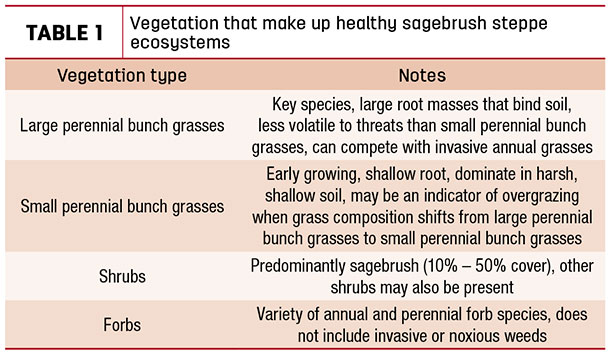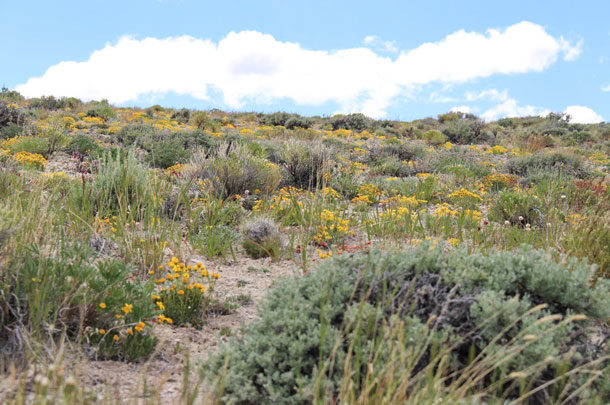A healthy sagebrush steppe ecosystem can support livestock grazing and wildlife habitat. However, developing proper management strategies has gone beyond balancing the needs of livestock and wildlife, to the need for controlling invasive plant species that threaten the health and longevity of the sagebrush steppe ecosystem.
In order to make good management decisions, it is important to first assess the condition of the sagebrush steppe ecosystem (Table 1). In healthy sagebrush steppe, expect to see sagebrush covering 10% to 50% of the area. Sagebrush is important for holding the soils and providing cover for wildlife, but it may also become too dense, which will decrease the opportunity for grasses and forbs to establish and grow. Additionally, perennial bunch grasses should be the predominant grass-type in sagebrush steppe, along with a good variety of forb species.

Invasive and noxious weeds have been a long-standing threat to sagebrush steppe ecosystems. More recently and prominently, invasive annual grasses, such as cheatgrass and medusahead, have taken over much of the Western grasslands. Additionally, in some areas, conifer (i.e., juniper) encroachment is a problem. For any of these threats, once they have reached or exceeded 10% of the vegetation cover, it is time to start managing to control and eradicate them. In many cases, invasive species may have already reached greater than 50% of vegetation cover, and at that point, management becomes much more difficult. Early and aggressive intervention of invasive species may be the only way to get ahead of the problem.
Rangeland conditions should be addressed and recorded each year, including information on approximate cover of vegetation types and the type, prominence, and location of any threats. Another great way to monitor trends is by taking photos at the same point each year, or even a couple times during the grazing season within a year. With this information, management goals can be established and corresponding short- and long-term management strategies can be developed. Over time, annually recorded information will provide insight on the long-term trends, whether or not the management goals are being achieved, and how management strategies should be adjusted.
Livestock grazing can be a great tool for managing rangelands, such as targeted grazing to reduce invasive species or rotational grazing management to promote establishment of perennial grasses. Once the management goals are set, apply grazing and other management strategies to achieve those objectives. There are many government and nonprofit land management groups that can assist with management plans and funding opportunities, including the local extension office, the Natural Resources Conservation Service (NRCS), U.S. Forest Service, the Bureau of Land Management (BLM), The Nature Conservancy, land management private consultants, etc. ![]()
Melinda Ellison is a range livestock extension specialist at the Nancy M. Cummings Research, Extension and Education Center at the University of Idaho.
PHOTO: An example of healthy range is pictured in Carmen, Idaho. Photo provided by Seth McFarland.









